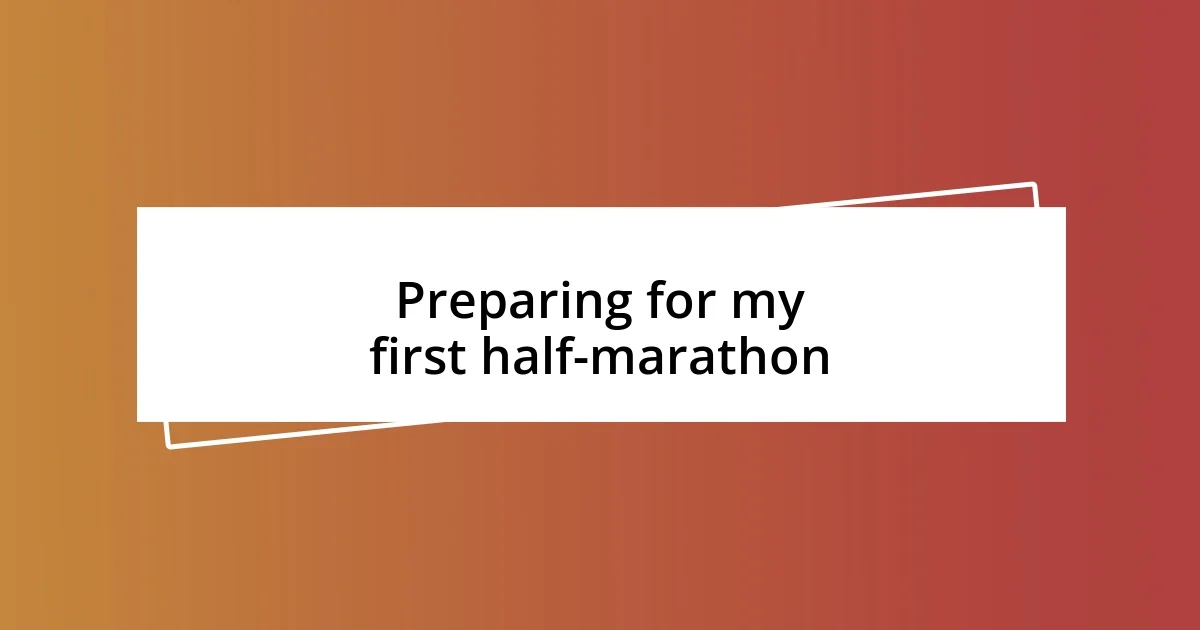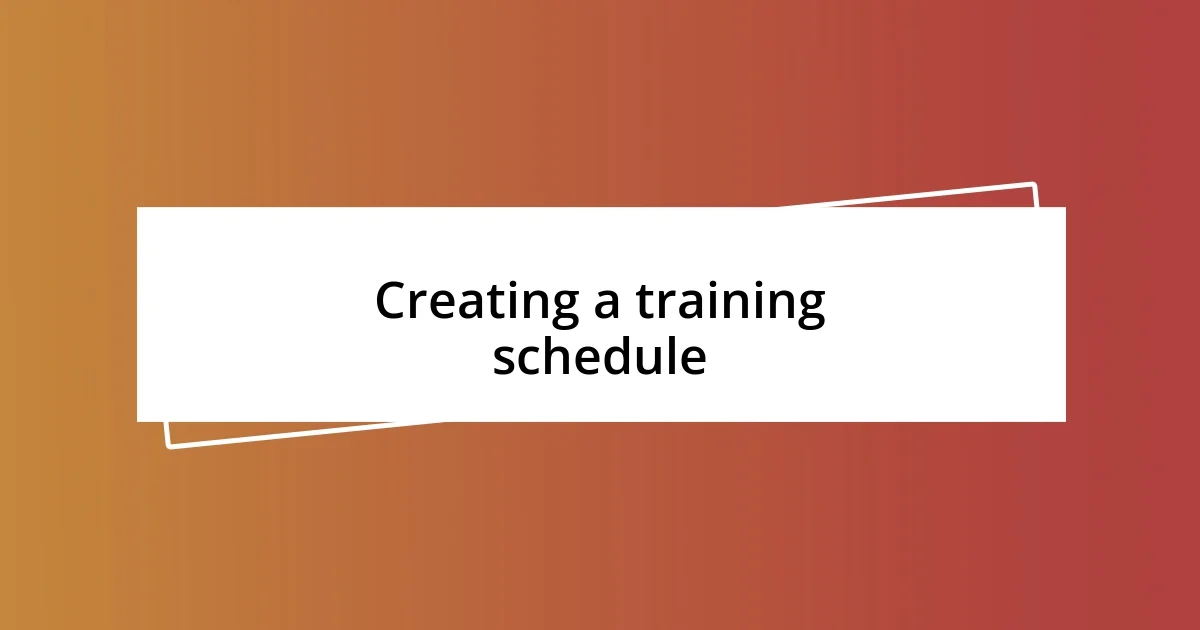Key takeaways:
- Structured training, including setting realistic incremental goals, is essential for preparing for a half-marathon.
- Nutrition and hydration significantly impact performance; fueling before and recovering after runs is crucial.
- Mental strategies, such as visualization and affirmations, help maintain focus and motivation during the race.

Preparing for my first half-marathon
When I first decided to tackle a half-marathon, the excitement was palpable, but it quickly settled into a whirlwind of preparation. I remember standing in my living room, staring at my running shoes and thinking, “Am I really ready for this?” A mix of enthusiasm and apprehension gripped me, but I knew I had to take the plunge and commit to a training plan that would guide me through every mile.
One of the most impactful decisions I made was to find a structured training program that matched my fitness level. As I mapped out my runs each week, I felt a growing sense of accomplishment, especially after crossing the threshold of my longest run yet. There were times I had to dig deep to push through the fatigue, and I found myself asking, “Why am I doing this?” In those moments, the answer became clear: it wasn’t just about completing the race; it was about discovering my strength and resilience along the way.
Fueling my body correctly was another crucial aspect of my preparation. I distinctly remember my first long run when I decided to experiment with energy gels for the first time. As I struggled to swallow the thick consistency mid-run, I thought, “Will this even help?” The reality hit me that nutrition plays a pivotal role in performance, and learning to listen to my body became a key lesson in my journey.

Setting realistic running goals
Setting realistic running goals is crucial for any aspiring half-marathoner. I remember sitting down with a calendar, feeling both excited and overwhelmed about the journey ahead. One thing I learned quickly was to break my overarching goal into smaller, more manageable targets. This approach not only kept me motivated, but it also allowed me to celebrate small victories along the way. For instance, I set goals for weekly mileage, focus on my pace during training runs, and even milestones like completing a 10K.
Here are some points to consider when setting your running goals:
- Assess Your Current Fitness Level: Understand where you’re starting from. This will help you set achievable targets.
- Set Incremental Goals: Break your training into weekly or monthly segments, like gradually increasing your distance or improving your speed.
- Be Specific: Instead of just saying “I want to run a half-marathon,” I committed to running it in under 2 hours, making the goal tangible.
- Factor in Rest: Allow time for recovery. Trust me, rest days are key to preventing burnout and injuries.
- Adjust as Needed: Life happens. If you need to tweak your goals, it’s okay. Flexibility will keep you engaged and motivated.

Creating a training schedule
Creating a training schedule is like crafting a blueprint for a small personal project; it needs to be precise and tailored. I started my journey by dedicating specific days to running, making sure to include a mix of distance and pace work. When I penciled in back-to-back long runs on the weekend, it didn’t just challenge my endurance; it gave me something to look forward to each week, almost like a mini-adventure.
As I put together my training schedule, I emphasized variety. Early on, I discovered that running the same routes can become monotonous. To combat this, I made it a point to explore different trails and neighborhoods. This change not only kept my enthusiasm high but revealed hidden gems in my surroundings, sparking a new joy in running for me. It was amazing how just altering my path could refresh my outlook on the entire experience.
A well-structured training schedule also includes recovery. I remember my first post-run stretch routine; I had completely underestimated the power of proper cooldowns. After one particularly grueling run, I felt utterly depleted, but taking the time to stretch helped me bounce back the next day, reminding me that rest and recovery are as vital as the runs themselves.
| Week | Workout Focus |
|---|---|
| Week 1 | Base building – Short distances, consistent pace |
| Week 4 | Incorporate speed work – Interval training |
| Week 7 | Long runs – Increase distance gradually |
| Week 10 | Taper – Reduce mileage, focus on rest |

Nutrition tips for runners
Nutrition is a game changer for runners, and it’s something I learned the hard way. I remember a long run where I didn’t eat properly beforehand; about halfway through, I hit a wall. It’s crucial to fuel up with a combination of carbohydrates and proteins before a run. For instance, I found that oatmeal with banana and a sprinkle of nuts did wonders for my energy levels. Have you found a breakfast that suits you?
During my training, I discovered the importance of staying hydrated. I used to underestimate how much water I really needed until I experienced a cramp mid-run that nearly knocked me off my feet. Now, I make it a point to carry a water bottle with me, even for shorter runs. It’s a simple addition, but I can’t stress enough how much it helps maintain stamina. How often do you check in on your hydration levels?
After those intense training sessions, recovery meals became my best friend. I learned that consuming a mix of protein and carbs within 30 minutes post-run helped me recover faster. I’d whip up smoothie bowls or perhaps a hearty quinoa salad, which not only filled me up but also made me excited about post-workout nutrition. If there’s one thing I’d recommend to any runner, it’s to experiment with different recovery meals; you might just find your new favorite dish!

Finding the right gear
Finding the right gear was a pivotal part of my half-marathon preparation. Initially, I thought any running shoes would suffice, but after my first few longer runs, my feet were crying out for mercy. It was during one visit to a specialty running store that I finally felt understood. The staff analyzed my gait and suggested shoes with better support tailored to my running style. Have you ever experienced that ‘aha’ moment when the right gear transforms your discomfort into pure joy?
As I dove deeper into selecting gear, I realized clothing made an enormous difference too. Lightweight, breathable fabrics kept me cool on those long training runs, and there’s nothing quite like the feeling of well-fitting gear that doesn’t chafe. I once made the mistake of wearing an old cotton shirt; it quickly became a sticky, irritating reminder of why technology matters. Instead, I invested in moisture-wicking tops that felt like a second skin. How much does your outfit influence your running comfort?
Lastly, I discovered the invaluable role of accessories. My love for music turned into a necessity when I found the right wireless headphones—lightweight and sweat-proof. I had a playlist that powered me through the toughest miles, yet I also learned to embrace the silence, focusing on my breath and the rhythmic thud of my shoes. It’s fascinating how the right gear can enhance both your performance and your mental state during a run. What’s your go-to gear that keeps you motivated?

Mental strategies for race day
When I approached race day, I knew that my mindset would play a pivotal role in how I performed. One of my go-to strategies was visualization. On the morning of the race, I closed my eyes and imagined myself crossing the finish line, feeling strong and accomplished. This exercise never failed to fill me with an overwhelming sense of determination. Have you ever found that mental imagery lifts your spirits?
Another powerful technique I relied on was affirmations. I crafted phrases like, “I am strong,” and “I can do this,” which I repeated quietly to myself in the weeks leading up to the race. On race day, as the nerves kicked in, I leaned on those affirmations. They became my mental anchors, transforming fear into excitement. How do you reaffirm your strength when doubt creeps in?
Lastly, I learned the importance of having a race day mantra. For me, it was simply, “One mile at a time.” This phrase kept me grounded amidst the chaos of the race. Each mile marker felt like a small victory, and focusing on one step at a time helped reduce the overwhelming nature of the distance. What mantra resonates with you when you face a challenge?

Reflecting on my race experience
Reflecting on my race experience, I find that each mile held a story. At around the 8-mile mark, I was enveloped by fatigue, but the energy of the cheering crowd became my lifeline. I remember glancing at a young boy holding a handmade sign that read, “You’re almost there!” It sparkled a renewed motivation in me, making me feel more connected to the people supporting my journey. Isn’t it amazing how motivation can come from unexpected places?
As I neared the finish line, emotions overwhelmed me. The mix of exhaustion and exhilaration didn’t just swell within; it burst forth in tears of joy. Crossing that line felt surreal, as if I had transcended my limits. At that moment, I understood what it truly meant to challenge myself. Was there ever a time when you pushed through something you once thought was impossible?
Looking back on the entire race, I realized it was less about the physical act of running and more about the journey of self-discovery. Each step taught me resilience and the power of community support. The experience made me grateful for every training run, every drop of sweat, and even the painful moments. Has a single event ever reshaped your perspective on your abilities?














